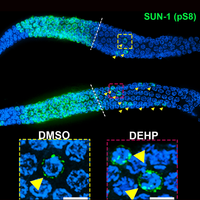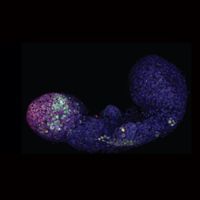embryogenesis

The First Two Cells in a Human Embryo Contribute Disproportionately to Fetal Development
Shelby Bradford, PhD | May 13, 2024 | 4 min read
A research team showed that, contrary to current models, one early embryonic cell dominates lineages that will become the fetus.

The First Human Embryo Model From Embryonic Stem Cells
Shelby Bradford, PhD | Mar 1, 2024 | 2 min read
Jacob Hanna developed a method for replicating embryogenesis outside of the uterus to understand the underlying mechanisms.

A Stem Cell Zoo Reveals Surprising Differences in Embryogenesis
Ida Emilie Steinmark, PhD | Sep 1, 2023 | 2 min read
By comparing stem cells from six mammals of different sizes, scientists discovered stark differences in embryonic development paces.

Claudia Gerri Studies the Mysteries of the Placenta
Katherine Irving | Feb 1, 2023 | 3 min read
At the Max Planck Institute of Molecular Cell Biology and Genetics, the developmental biologist is probing the maternal-fetal interface across mammalian species.

Hematopoietic Stem Cells and Their Role in Development and Disease Therapy
Jennifer Zieba, PhD | Aug 24, 2022 | 5 min read
Hematopietic stem cells (HSCs) are multipotent cells found in the blood and bone marrow with the ability to self-renew and differentiate into multiple cell types during bone marrow hematopoiesis

Mouse Embryo: No Sperm, Egg, or Uterus Required
Christie Wilcox, PhD | Aug 2, 2022 | 3 min read
Using stem cells and a bioreactor, researchers generated living embryos that survived for more than a week and began to develop internal organs.

Developmental Biologist Kathryn Anderson Dies at 68
Amanda Heidt | Jan 6, 2021 | 4 min read
The Sloan Kettering researcher used mutagenic screening to probe genes and molecular pathways, including Toll and Hedgehog, essential to development in fruit flies and mice.

Image of the Day: Impaired Meiosis
Amy Schleunes | Feb 7, 2020 | 1 min read
A phthalate commonly found in shampoos, cosmetics, and cleaning products disrupts reproduction in worms.

Mouse Stem Cells Made to Form Embryo-Like Structures
Ruth Williams | Oct 3, 2018 | 3 min read
With just a molecular nudge, aggregates of embryonic stem cells take shape as a “gastroloid,” bearing the genetic hallmarks and spatial organization of early development.

Animals’ Embryonic Organizer Now Discovered in Human Cells
Jim Daley | May 23, 2018 | 4 min read
The finding confirms that a cluster of cells that directs the fate of other cells in the developing embryo is evolutionarily conserved across the animal kingdom.

Studies Show How Cells Differentiate at Life’s Beginning
Shawna Williams | Apr 27, 2018 | 1 min read
A trio of papers provide new insight into embryo development.

Eat Yourself to Live: Autophagy’s Role in Health and Disease
Vikramjit Lahiri and Daniel J. Klionsky | Mar 1, 2018 | 10+ min read
New details of the molecular process by which our cells consume themselves point to therapeutic potential.

Coming to Terms
Anna Ajduk and Magdalena Zernicka-Goetz | Nov 1, 2012 | 10+ min read
New noninvasive methods of selecting the most viable embryo could revolutionize in vitro fertilization.
The Sharper Image
Jeffrey M. Perkel | Oct 1, 2012 | 7 min read
Advances in light microscopy allow the mapping of cell migration during embryogenesis and capture dynamic processes at the cellular level.
Of Frogs and Embryos
Karen Hopkin | Sep 1, 2012 | 1 min read
Associate Professor in Molecular Cell & Developmental Biology at the University of Texas at Austin, John Wallingford, makes his living using cutting-edge microscopic techniques to watch developmental events unfold in real time.
Taking the Long View
Karen Hopkin | Sep 1, 2012 | 9 min read
In exploring how embryos take shape, John Wallingford has identified a key pathway involved in vertebrate development—and human disease.
Never Say Never
H. Steven Wiley | Feb 1, 2012 | 3 min read
Novel observations can sometimes be correct for unexpected reasons.
Embryos Right Genetic Wrongs?
Amy Maxmen | Jul 8, 2011 | 3 min read
New evidence supports an old idea that embryos with genetic abnormalities can somehow fix themselves early in development.
